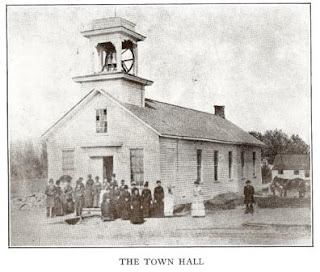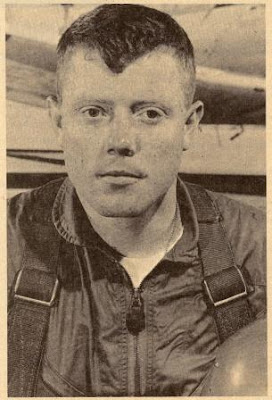My
final salute to veterans this month is to my own maternal grandfather. His
name was Frank Kargleder. I never got to know him in life, so over the
years have tried to learn more about him through my mother’s recollections,
photos and historical records. Mother
had a few pictures of Frank in his World War I army uniform and thought he had
served in France, but beyond that, we knew nothing about his service. I attempted to obtain his service records,
but found out that they had been destroyed in a fire at the National Personnel
Records Center in St. Louis back in 1973.
I had resigned myself to the fact that I would probably never know how
and where he had served. Then, late one
night when sleep eluded me, I remembered that veterans who were land owners
often filed their discharge papers with the local government in order to obtain
a real estate tax credit. The next day I
wrote a letter to the Veterans Service Office of Roberts County, South Dakota,
where he had lived and lo and behold by return mail I received a copy of his
discharge papers which disclosed a wealth of information.
 |
| Frank Kargleder |
His Early Years
Frank
B. Kargleder was born June 12, 1892 in Kossuth County. His parents, Charles and Anna (Rammer)
Kargleder, lived on a farm in Lotts Creek township. He was the oldest of seven children. The Kargleder family lived on
the farm until 1903 when they sold their farm land and moved to a farm near Big
Stone City, South Dakota. It was there
that Frank finished school.
His Service
He
entered the service on October 5, 1917 at Sisseton, South Dakota. Frank was 25 years old and listed his
occupation as a farmer. His rank is
listed as wagoner. A wagoner was a form
of Private First Class with a special skill, an Army teamster. A teamster is a driver of a team of horses
doing hauling. I cannot confirm where he
received his initial training, but it is likely that he went to Fort Funston in
Kansas. There the 89th
Division, American Expeditionary Forces were housed. Known as the Middle West Division, it
consisted of recruits from Kansas, Missouri, South Dakota, Nebraska, Arizona,
Colorado and New Mexico.
Using
the facts contained in his discharge papers, I gathered information from
reflections of other soldiers and from various sources such as “The People’s
War Book,” and the “Kansas 353rd Infantry Regiment in WWI” as found
on FamilyMilitaryRecords.com. The 353rd
was in the 89th Division as was the 340th Infantry in
which Frank served. All departure and
return dates of these two regiments matched as did the battles and engagements
in which they were involved.
Company
D, 340 Infantry to which Frank belonged departed for France on June 4,
1918. Upon arrival in France, the
Division was immediately ordered to the Reynel training area near Haute-Marne
except for the Divisional artillery which was order to Camp Souge, near
Bordeaux for training. The Division
remained in the Reynel area until August 5th when it began its
occupation of Lucey Sector which continued until September 12, 1918.
 |
| On back of photo: "A nice little gun ready for business." |
From
September 12th through September 16th, the Division
participated in the St. Mihiel offensive as the right division of the 4th
American Corps and advanced to a depth of twenty-one kilometers including the
capture of the towns of Beney, Essey, Boullionvile, Pannes and Xammes.
From
September 16th until October 7, 1918, the Division occupied the
Euvezin Sector. The Division became part
of the Reserve Fifth Corps from October 9th through the 19th.
 |
| On back of photo: "Down along the creek near our camp there is timber." |
On
October 19th the Division moved forward in rear of the 32nd
Division as a part of the 5th American Corps in the Meuse-Argonne
offensive moving through Bantheville Woods and on October 20th the
Division went into the line along the Sommerance-Romagne road just north of the
Kreimhilde defense positions. The Division
attacked on November 1st and continued in the assault until the
armistice was signed when it had crossed the Meuse north of Stenay.
 |
| On back of photo - "Right on the creek. Going to catch wet feet." |
The
Division participated as part of the Army of Occupation from November 24, 1918,
until May 6, 1919, when the Division boarded the U.S.S. Leviathon at the Port
of Brest, France, and arrived back in the U.S.A. on May 22, 1919.
During
its service, the Division captured from the enemy the following: 5,061 prisoners, 127 pieces of artillery, and
455 machine guns. The Division advanced
36 pieces of artillery. The Division
advanced 36 kilometers against resistance; suffered 1,419 battle deaths and
7,394 wounded; and had one officer and 24 men taken prisoner.
Home At Last
Frank
was discharged at Camp Dodge, Iowa, on June 2, 1919. He taught school for several years and then
later had a pharmacy in White Rock, South Dakota, until he retired and moved to
California.
The
effects of the war lingered on. Frank
shared with his daughters that he was a victim of gas warfare during
combat. Gas warfare was employed on a
large scale by both sides—initially, with serious effects. Countermeasures were promptly developed, however,
and poisonous gas became a harassing rather than a decisive weapon. The trench warfare at the time also had to
have been a very harrowing experience, leaving grim memories for each veteran
to process.
Frank
died November 13, 1971, and was laid to rest in Good Shepherd Cemetery in
Huntington Beach, California. Although I
never got to know him or talk with him about his wartime experiences, I am so
proud of this brave young soldier and his service in making our world a safer
place.
Until
next time,
Jean
(a/k/a KCHB)
If you enjoyed this
post, please don’t forget to “like” and SHARE to Facebook. Not a Facebook
user? Sign up with your email address in the box on the right to have
each post sent directly to you.
Be sure to visit the
KCHB Facebook page for more interesting info about the history of Kossuth
County, Iowa.
Reminder: The posts on Kossuth County History Buff are ©2015 by Jean
Kramer. Please use the FB “share” feature instead of cutting/pasting.









